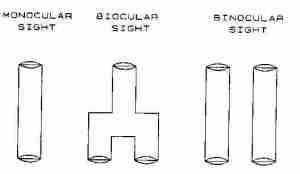Articles >>
Monocular, Biocular, and Binocular Sights
Category: Term of the day

Monocular sight is an optical system with a single objective lens and a single eyepiece. The eyepieces of most modern high magnification sights are either monocular or biocular. Monocular sights, in which the scene is presented to one eye, are the simplest and produce the minimum light loss, although they can cause eye strain and other physiological problems, especially when used for long periods. Also, since each eye is connected to one side of the brain, the monocular system does not make full use of the operators cognitive facilities.
With biocular eyepieces, the light enters the sight via a single objective lens and is divided by a beam splitter, with the same image being presented to both eyes. Although the beam splitter causes some light loss, the overall effect is beneficial. Apart from the reduction in eye strain, there is evidence that operator performance is improved by some 10% to 15% when both eyes are used.
From the performance point of view, the optimum system is the binocular, in which each eye has a totally independent channel. However, binocular systems are rarely used because they have a number of disadvantages. In particular, they need a larger aperture in the turret, the increased number of components makes them more expensive and they require careful setting up and maintenance to keep the two channels optically aligned. |
Discuss
